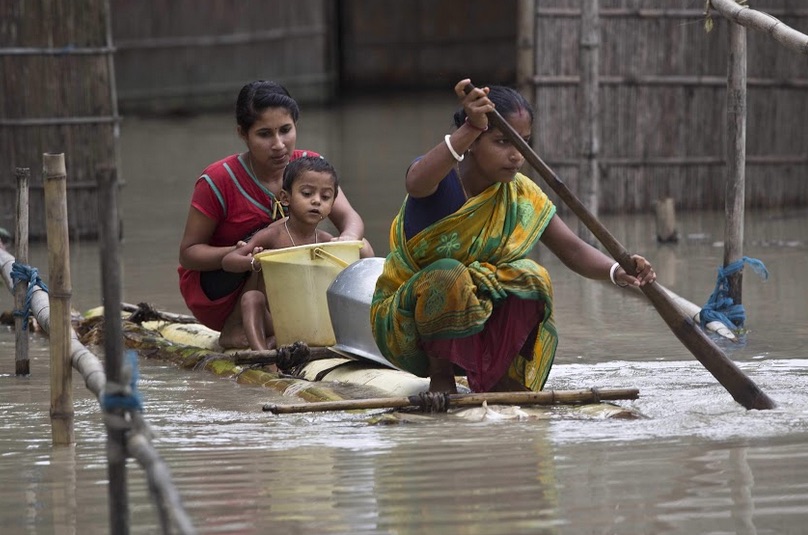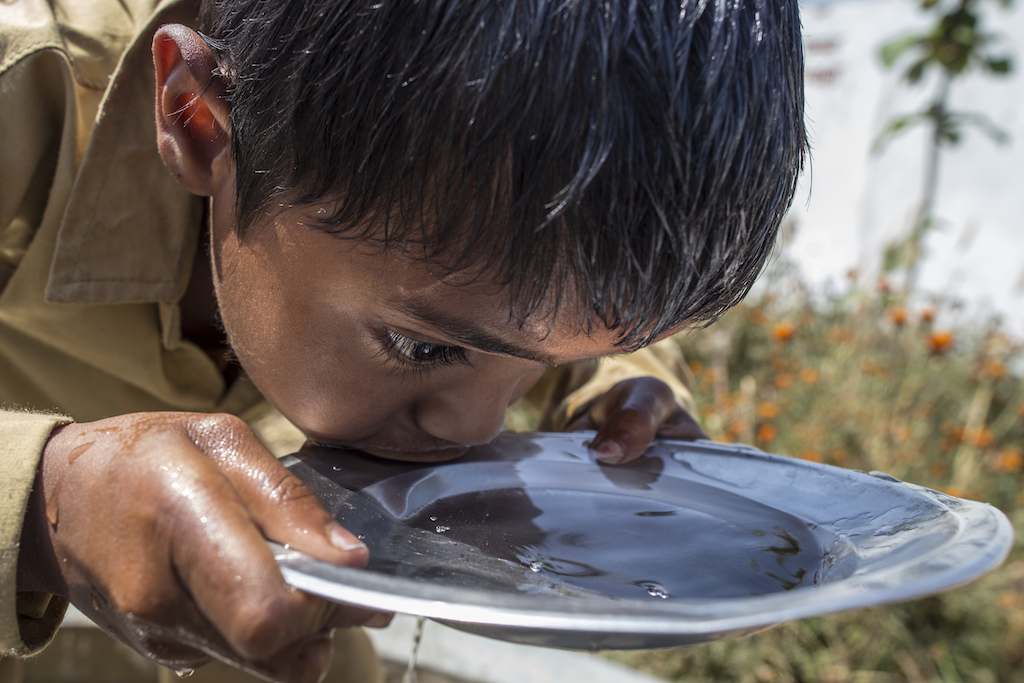The news over the past month has been filled with devastation. Flooding in Mumbai and across India has washed away homes, spread disease, sparked landslides and damaged core infrastructure. Globally, thousands have experienced catastrophic flooding, cyclones, hurricanes and earthquakes.
When we see suffering like this, our hearts are touched and we naturally want to help somehow. We want to make a positive difference. The question that comes up is “How can I help?” With limited time and resources, it can be unclear what’s best.
Some of the questions we might puzzle over are:
- There are so many problems: Which causes should I support?
- Which charities are trustworthy, and will use my donation efficiently?
- How much should I give, and what can I afford to give?
- Is it better to send clothes, blankets and food, rather than money?
- I have useful skills, maybe I should volunteer my time instead?
If you’re thinking about this, it is wonderful because it shows you care. But don’t let the questions confuse you, or dampen your initial flame to act. In this month’s Maitri Moves we explore 10 ways to be effective in our charitable endeavours.
How much happiness can you spread?
Imagine it is a very hot day, and you come across a thirsty child on the street that is just about to die! You realise you have a water bottle in your bag, and you give it to child, saving his life. That day might be one of the most important moments of your entire life. You would feel so happy that you were able to make a difference!
Now imagine you start to give a regular donation to a children’s charity that is saving lives by providing clean water. This simple act of generosity is no less than the heroic one on the streets, and in fact you could be saving several children’s lives every year! This is such an astonishing fact. Even a small donation can have a big impact.
It is only when we make this positive mental and emotional connection to the impact our actions can have, that we can become motivated to do more. That’s why reading case-studies, talking to charity workers about their first-hand experiences, or even visiting projects ourselves, can inspire us immensely.
But once we are motivated, how do we decide what to do? There are so many problems, and so many charities - it can be confusing. This is why we are sharing 10 moves we can each make, to improve our effectiveness. Let’s jump right in.
10 Moves for Effective Philanthropy
Move 1: Pure intentions
In Jainism it is recognised that the intent, motivation or “bhav” is fundamental - even more important than the action itself. This short video shows a little boy, that will surely inspire everyone to give charity from the heart, with no expectation of any reward or recognition. When we are looking to be effective in philanthropy, egoistic desires can be a distraction, taking us away from our real goal of helping. It is only because we are blessed with gifts, that we can share these with others.
Move 2: How much can I afford to give? (Take this test!)
All of us reading this are probably quite wealthy in global terms (compared to others). Have a guess at how rich you are by global standards and then take this test to see how rich you really are. This insight might be a good starting point to consider how much you can afford to give. Once you have thought about it, you may wish to allocate a % of your income you are willing to give to charity every year.
““Never respect men merely for their riches, but rather for their philanthropy; we do not value the sun for its height, but for its use.” ”
Move 3: Be passionate enough to research what works
Many of us donate based on our charitable impulse when someone asks - perhaps someone we know that is involved in social causes, or at a fundraising event. We feel good that we took action. However this is a reactive way of giving, and often plays on our emotions. To be more effective we must be proactive, and find out more about the causes that we wish to support.
In the history of charitable initiatives, there are many examples of ideas that sound innovative, but have not been tested thoroughly so is not ready to be scaled. For example, a few years ago a lot of money was wasted in a highly popular initiative called Playpumps in which a lot of assumptions had not been tested out.
There is an initiative called Effective Altruism that is encouraging people to think more carefully using evidence and reasoning, about what to support. This kind of rational analysis doesn’t take away from the joy of giving, rather it enhances the joy!
“In most areas of life, we understand that it’s important to base our decisions on evidence and reason rather than guesswork or gut instinct. When we seek medical treatment, we want treatments that have been shown to work through scientific trials. When we invest money, we try to get as much information as we can about all our options to find out what will give us the greatest return. When we look to buy a product, we read customer reviews to find out if what we’re buying really works. Yet when it comes to doing good, too often we lose these standards.”
Move 4: Think from the point of view of the charity
Make it an annual commitment:
Once we find charities we wish to support, the ideal way of supporting them is to make a monthly or annual commitment. This is incredibly useful to the charity - so they can plan and know what is achievable each year.
For example, for our Raj Saubhag Ashram charity work, even though the donations are generous, they are also unpredictable, making it difficult for the management teams to plan ahead. Can we build that extra classroom? Can we hire that extra cleaner? These decisions are hard to make without accurate financial forecasting.
Fund core capacity and overheads:
Most donors want to know “How much of our money actually goes to the people in need (beneficiaries)?” But have you ever wondered, if all of our money went to the beneficiaries, then how do we expect the charity to function? Who would pay for the research, evaluation, computers and staff to write reports for the donors?
When we look at the charity's effectiveness through the narrow lens of how much money goes to beneficiaries, then - ironically - it weakens the capacity to be effective.
Move 5: Donating even when there is no “emergency”
When there is a headline grabbing emergency, like a major flooding or earthquake, people are much more generous with their donations. The charities that work on these issues usually find that they are “overfunded” in times of big crises, and underfunded for the rest of the time when they are working on the everyday challenges to alleviate suffering.
Some of the important work that it is done throughout the year by charities, also helps to support communities to be more prepared and resilient to handle any potential future crisis. Investing in areas like education, women’s empowerment, poverty alleviation, can all make communities stronger.
Move 6: Don’t just follow trends - support the neglected areas
Like in every sphere of life, charity donations go through trends. Causes rise and fall in their popularity. Some important issues are taboos - such as menstrual hygiene - so it is particularly difficult to get funding for these. Other causes make us feel bad - such as reducing slave labour in manufacturing the electronics and clothes that we love - so the charities that talk about these sensitive issues are unpopular. Celebrities also influence which causes and charities are in the limelight.
Given that there are so many worthwhile causes, let us look for areas that lack funding, and actively go and support those. For example, in our own Raj Saubhag Ashram’s charitable projects, some initiatives receive far more funding than others - so why not find out where the unmet needs are and actively try to fill these gaps?
Move 7: Let’s solve the problems, not just treat the symptoms
With any problem, there is always an underlying issue that needs to be solved. We all know that “prevention is better than cure”, so let us look for opportunities to solve the root of problems, rather than just treating the symptoms of those suffering today. With the right planning, both can be done together.
““Effective philanthropy requires a lot of time and creativity - the same kind of focus and skills that building a business requires.””
For example at the Raj Saubhag Ashram managed community hospital in Sayla, there are a high number of women that have health complications during pregnancy and during the delivery of their babies. In addition to providing mothers with the medicines they need, the Ashram has also run community projects (Jyot) to educate young women about what they need to do to remain healthy during a pregnancy.
The trouble is most donors are far more willing to fund treatment, than prevention. This is because the results of treatments are tangible - we can count the number of lives improved or saved. The impact of longer-term programmes that focus on behavioural change are more difficult to measure. This is when we need to think like farmers that plant seeds and patiently nurture the fields.
Move 8: Every small donation counts
When the problems are large and complex, it can feel meaningless to give a small amount. But that is not true - small donations can go a long way. For example, malaria kills millions of people every year - a child dies of malaria every 30 seconds! Yet a bed net that prevents children being infected while they sleep costs less than $10. That small donation can change the lives of an entire family.
Modest donations can also help charities to overcome hurdles. Often a charity gets stuck because it is unable to finance a specific need, which is needed to move onto the next stage of their growth and impact. It could be as simple as buying a printer, or a scooter. For example, at Raj Saubhag Ashram’s Ashirvad, the donation of funds just to buy a small van has enabled the centre to pick up and drop disabled children from villages much further away. As a result of reaching out to these new communities, there are now many other related projects happening there.
Move 9: Giving your time and talent (not just money)
Giving is not about money, it is about compassion. And we don’t always need money in order to express our compassion, and make a difference. Read these inspiring everyday examples, and think about what you could do.
- “Do Something For Nothing” is an initiative set up by a hairdresser in London who gives free haircuts to the homeless. This simple act transforms the self-esteem of those living on the streets, as well as helping them to apply for jobs. Their motto is “We’re not raising awareness, we’re raising compassion”
- Flute teacher, Himanshu Nanda, is giving free lessons to children with Autism Spectrum Disorder for therapeutic purposes. He says “When I interact with these children, I feel amazed. The purity of their heart, inexplicable love for music has inspired me to work for them.”
- In London there is a group that run “Listening Cafes” monthly, in which they invite people from the streets to come and talk for 4min, and the volunteers simply listen with kindness. It is said that attention is the rarest and purest form of generosity. You too could give a few minutes of your attention to help someone lonely feel cared for.
Move 10: The power of prayers
May we never underestimate the power of sending loving wishes to all. Take out time to sit in silence and pray for the happiness of all souls. Perhaps you can do this for a few moments everyday after reading about all the suffering in the news. It is far more useful than getting angry, or feeling depressed. Not only do intense compassionate thoughts support us in our own inner awakening, but they also enhance the level of peaceful vibrations in the universe.
Photo credit
http://www.girlsnotbrides.org/themes/poverty/
Giving What We Can https://www.givingwhatwecan.org/
Water Aid https://www.wateraid.org.uk
છેલ્લા થોડા મહિનાઓથી આપણે બરબાદીના સમાચારો સાંભળી રહ્યા છીએ. મુંબઈ અને ભારતભરમાં આવેલા પૂરને કારણે હજારો ઘરો તણાઈ ગયા છે, રોગચાળાનો ફેલાવો થયો છે, ભૂસ્ખલન અને માળખાભૂત સગવડો જેમ કે, રસ્તાઓ, વીજળી પૂરવઠો વગેરેને ખૂબ જ નુકશાન થયેલ છે. વિશ્વભરમાં હજારો લોકોને ભયંકર વાવાઝોડા, ચક્રવાત, પૂર અને ધરતીકંપ જેવી અનેક કુદરતી આપત્તિઓ સહન કરવી પડી છે.
જ્યારે આપણે લોકોને આ તકલીફો સહન કરતાં જોઈએ છીએ, ત્યારે આપણું હૃદય દ્રવી ઉઠે છે અને કુદરતી જ આપણે કોઈને કોઈ રીતે સહાયરૂપ થવા માટે તત્પર બનીએ છીએ. ત્યારે પ્રશ્ન એ ઊઠે છે કે ‘હું કઈ રીતે મદદરૂપ થઈ શકું?’ મર્યાદિત સમય અને સ્ત્રોતોને કારણે શું થઈ શકે તે સમજાતું નથી.
અમુક પ્રશ્નો આપણા માટે કોયડારૂપ હોય છે જેમકે,
૧) ઘણા પ્રકારની સમસ્યા છે તો કોના માટે સહાયરૂપ થવું?
૨) કઈ સખાવતી સંસ્થાનો ભરોસો કરી શકાય કે જ્યાં મારા આપેલ દાનનો બરાબર સદ્ઉપયોગ થશે? (જરુરિયાતમંદ લોકો સુધી પહોંચાડશે?)
૩) મારે કેટલું આપવું જોઈએ, જે મને પોસાય?
૪) રોકડાં આપવા કરતાં કપડાં, ધાબળા અને ખાધાખોરાકીની વસ્તુ આપવી સારી રહેશે?
૫) મારી પાસે આવી આવડત છે તો શું હું સ્વયંસેવક બનીને મારો સમય આપું?
જો તમે આ બધું વિચારતા હોય તો તે ઘણી જ સારી બાબત છે. તે દર્શાવે છે કે તમે બીજા લોકોને માટે સહાયરૂપ થવા તત્પર છો. પણ આ પ્રશ્નોથી મૂંઝાતા નહીં કે શરૂઆતમાં સહાયરૂપ થવા માટેની આગને બૂઝવા દેતા નહીં. આ મહિનાનાં Maitri Movesમાં આપણે દસ પ્રકારે આપણા સખાવતી પ્રયાસોને વધું અસરકારક બનાવવાનો પ્રયત્ન કરીશું.
તમે કેટલી ખુશીઓ ફેલાવી શકો છો?
વિચારો, કે ગરમીનો દિવસ છે અને ગલીમાં તમે કોઈ ગરીબ બાળક જે તરસને કારણે તરફડી રહ્યું છે, તમને ધ્યાનમાં આવે છે કે તમારી પાસે પાણીની બોટલ છે અને તે બોટલ તમે તે બાળકને આપો છો. જેથી તેની જીંદગી બચી જાય છે. તે દિવસ કદાચ તમારી જીંદગીમાં ખૂબ જ મહત્વની પળ લાવે છે, તમે બેશૂમાર ખુશી અનુભવો છો કારણ કે કોઈની જીંદગીમાં એક નાનો બદલાવ લાવી શકવાનું તમે કારણ બન્યાં છો.
હવે વિચારો કે તમે નિયમિત રીતે બાળકોને માટે જે સંસ્થાને દાન આપો છો તેઓ બાળકોને સ્વચ્છ પાણી આપીને ઘણી જીંદગીઓ બચાવે છે ભલે આ એક સામાન્ય ઉદારતા બતાવતું કાર્ય હોય પણ તે કોઈ રસ્તા પર બતાવાતા પરાક્રમથી ઓછું નથી. કદાચ આ રીતે તમે દર વર્ષે ઘણાં બાળકોની જીંદગી બચાવી શકો છો. આ ઘણી આશ્ચર્યકારક હકીકત છે એક નાના દાનની પણ બહુ જ મોટી અસર હોય છે.
આવી સકારાત્મક માનસિકતા તથા લાગણીશીલતા જો આપણા દાનનાં કાર્ય સાથે જોડવામાં આવે તો જ આપણે હજુ વધારે કરવા માટે પ્રેરિત થઈએ છીએ. તેનાં માટે જો બનેલા પ્રસંગોનો અભ્યાસ કરીએ, સખાવતી સંસ્થાઓના કાર્યકરો સાથે વાત કરીએ કે પછી તેઓની ચાલી રહેલ યોજનાના સ્થળે મુલાકાત લઈએ તો આપણને ખૂબ જ પ્રેરણા મળે છે. પણ એક વખત પ્રેરણા મળે તો પછી શું કરવાનું તેનો નિર્ણય કેવી રીતે લેવો? આપણી આજુબાજુ અનેક પ્રકારની મુસીબતો અને તેની સામે લડવા માટે સખાવતી સંસ્થાઓના અનેક પ્રયાસો ચાલી રહ્યા હોય છે જે કદાચ થોડું મૂંઝવણભર્યું હોય, તેથી જ અમે ૧૦ પ્રકારના પ્રયત્નો આપને દર્શાવીએ છીએ જે આપણને વધારે અસરકારક રીતે આવા કાર્યો કરવા માટે મદદ કરશે.
અસરકારક દાનવૃતિ માટે ૧૦ પગલાં :
(૧) શુધ્ધ ભાવ (દાનત)
જૈન ધર્મમાં કોઈ પણ કાર્ય કરતા પણ કાર્ય પાછળ રહેલ ઉદ્દેશ અથવા ભાવને ખૂબ જ પ્રાધાન્ય આપવામાં આવ્યું છે. આ ટૂંકા વિડિયોમાં નાના છોકરાને દર્શાવાયો છે તે જરૂરથી દરેક જોનારને હૃદયથી દાન આપવા માટે પ્રેરણા આપે છે. તે બાળક કોઈ પણ પ્રકારની માન્યતા કે પુરસ્કારની અપેક્ષા વગર દાન આપે છે. જો આપણે સમાજ માટે અસરકારક રીતે દાન આપવું હોય તો તેમાં આડે આવતી અહંકારની ભાવનાને અવરોધવી જોઈએ જે આપણને મદદ કરવાનાં મુખ્ય ઉદ્દેશ તરફથી દૂર લઈ જાય છે. આ ફક્ત અને ફક્ત ભેટ રૂપી આર્શીવાદ છે જેને આપણે બીજાઓ સાથે વહેંચીએ છીએ.
(૨) હું કેટલું આપી શકું?
જે કોઈ આ વાંચી રહ્યાં છે તેઓ વૈશ્વિક સ્તરે બીજાની સરખામણીમાં કદાચ ખૂબ જ શ્રીમંત લોકો છે. તમે જ અનુમાન કરો કે વૈશ્વિક સ્તરે તમે કેટલા શ્રીમંત છો અને પછી આ એક પરીક્ષાથી તે અનુમાનની ચકાસણી કરો. તે તમને સુઝાડશે કે તમે કેટલું આપી શકો છો? એક વખત તેના પર વિચાર કર્યા પછી તમે તમારી આવકનાં અમુક ટકા વર્ષે દાનમાં આવવાનું નક્કી કરી શકો.
(૩) જાણો, દાન ક્યાં અને કેવી રીતે વપરાય છે ?
જયારે આપણને કોઈ દાન માટે પૂછે ત્યારે આપણામાં રહેલ દાનવૃતિનો આવેગ સહજ રીતે ઉછળીને બહાર આવે છે. તેમાં પણ જયારે આપણને પૂછવાવાળી વ્યક્તિ કોઈ આવા સામાજીક કાર્ય સાથે જોડાયેલ હોય તો તેમાં જોડાવાથી આપણને પણ સારું લાગે છે. આ આપવાની વૃત્તિ તો પ્રતિક્રિયા રૂપ હોય છે અને મોટાભાગે તો તે આપણી લાગણી સાથે જોડાયેલ છે વધારે અસરકારક બનવા માટે આપણે સક્રિય રીતે ભાગ લેવો જરૂરી છે અને બીજા અનેક કર્યો જાણવા જરૂરી છે જેમાં આપણને મદદરૂપ થવાની ભાવના હોય છે.
આવી સખાવતી પહેલના ઇતિહાસમાં બીજા પણ ઘણા દાખલા છે જે એકદમ નવીન લાગે પણ તે ઘણી વાર નુકશાન સર્જે છે જેના વિષે પૂરતી જાણકારી નથી હોતી. દા.ત. થોડા વર્ષો પૂર્વે, ખૂબ જ જાણીતી પહેલ જે `પ્લેપમ્પસ’ તરીકે ઓળખાઇ હતી તેમાં અપૂરતી ધારણાઓને કારણે ઘણું જ ધન બરબાદ થયું હતું.
‘ઇફેકટીવ ઑલતૃઇઝમ’ નામે એક પહેલ શરુ થયેલ જેમાં લોકોને પુરાવા અને તર્ક આપીને સમજણપૂર્વક વિચારીને કોને અને કેવી રીતે મદદ કરવી તે સમજવામાં આવેલ. આવી કોઈ વ્યવસ્થિત રીતને અનુસરવામાં આવે તો વિશ્વેષણ વ્યર્થ ન જતાં ખરેખર તો આપણને દાન આપવાનાં કાર્યમાં પુષ્કળ આનંદ મળે છે.
જીવનનાં મોટા ભાગનાં ક્ષેત્રોમાં આપણે જે નિર્ણયો લઈએ છીએ તે આંતરિક સ્ફુરણા કરતાં પણ પુરાવા અને તર્ક દ્રારા નક્કી કરીએ છીએ. જ્યારે આપણને તબીબી સારવારની જરૂર પડે છે ત્યારે તે આપણે વૈજ્ઞાનિક કસોટી પર પાર ઉતરેલ હોય તેવી પસંદ કરીએ છીએ. જ્યારે આપણે કોઈ રોકાણ કરવા ઇચ્છતા હોઈએ ત્યારે તેને લગતી બધી જ માહિતી તપાસી જઈએ છીએ જેથી આપણને ઉચ્ચ વળતર મળી રહે. આપણે કોઈ વસ્તુની ખરીદી કરી રહ્યા હોઇએ છીએ ત્યારે તેના માટે ગ્રાહકોના અભિપ્રાય વાંચીએ છીએ અને પછી નિર્ણય કરીએ છીએ પણ આપણે એક સારું કાર્ય કરવા માટે આપણા નક્કી કરેલાં ધોરણોને ઢીલા છોડી દઈએ છીએ.
(૪) સખાવતી સંસ્થાના દૃષ્ટિકોણથી વિચારવું. વાર્ષિક સખાવત માટે વચનબદ્ધ થવું.
એક વખત જે સંસ્થાને સખાવત કરવાનું નક્કી કરો પછી આદર્શ રીત છે કે દર માસિક અથવા વાર્ષિક સખાવત માટે વચનબદ્ધ થવું. તેને લીધે સખાવતી સંસ્થાઓ પણ તે પ્રમાણે આયોજન કરી શકે છે.
દા.ત. આપણા રાજ-સૌભાગ આશ્રમની સેવા-પ્રવૃતિ માટે ઉદારતાથી દાન આવે છે પણ તે ક્યારે-કેટલું આવશે તે નક્કી નથી હોતું જેના કારણે વ્યવસ્થાપકો અગાઉથી આયોજન નથી કરી શકતા. ચોક્કસ નાણાકીય આયોજન વગર અમુક નિર્ણયો લેવા મુશ્કેલ થઈ જાય છે. જેમ કે શાળા માટે એક વર્ગખંડનું બાંધકામ કરાશે? અથવા તો એક વધારાના સફાઈ કામદારને કામે રખાશે?
સખાવતી સંસ્થાઓની ક્ષમતા તથા ખર્ચ :
દાન આપવાવાળા મોટા ભાગનાં લોકોને જાણવાની વૃતિ હોય છે કે તેમનું આપેલ કેટલું દાન ખરેખર જરૂરીયાતમંદ લોકોને પહોંચ્યું છે? આ પ્રશ્ન પણ વિચારવા લાયક છે કે જો પૂરેપૂરી રકમ જરુરિયાતમંદ લોકોને અપાય તો સખાવતી સંસ્થાનું સંચાલન કેવી રીતે થશે? તેમના સંશોધન, મૂલ્યાંકન, કોમ્પ્યુટર અને કાર્યકતા જેઓ આ રિપોર્ટ બનાવે છે તેમના માટેનો ખર્ચ કોણ આપશે?
જરુરિયાતમંદ લોકો સુધી કેટલું ધન પહોચ્યું તે જ દૃષ્ટિકોણથી વિચારીએ તો આ સંસ્થાઓની અસરકારકતા ઓછી જ લાગે !
(૫) આપત્તિના સમય વગર પણ દાન આપવું
પૂર કે ધરતીકંપના સમાચારોથી સમાચાર પત્રો ભરેલા હોય ત્યારે લોકો દાન આપવા માટે તત્પર થયેલા હોય છે. આ કારણોને માટે મળેલું દાન ઘણી વખત વધુ પડતું જમા થાય છે અને બાકીના સમયે જયારે આ સંસ્થાઓને રોજબરોજની સમસ્યાઓને દૂર કરવા માટે ધનની જરૂરિયાત હોય છે ત્યારે ખૂબ જ ઓછું દાન-ભંડોળ મળે છે.
આ સંસ્થાઓ આખા વર્ષ દરમિયાન બીજું એક મહત્ત્વનું કાર્ય કરે છે જેમાં તેઓ સમાજના વર્ગોને ભવિષ્યમાં અણધારી આવનારી આપત્તિઓ સામે લડવા માટે તૈયાર રહેવામાં મદદ કરે છે. ભણતર, નારી સશક્તિકરણ, ગરીબી નિવારણ વગેરે માટે કરેલ રોકાણ પણ સમાજને સશક્ત બનાવે છે.
(૬) ચીલાચાલુ શૈલીને નહીં અનુસરતા, ઉપેક્ષિત વિસ્તારોને પણ મદદ કરો
જીવનના દરેક ક્ષેત્રની જેમ દાન દેવામાં પણ ફેશનનું ચલણ હોય છે. જેના કારણે તેમની લોકપ્રિયતમાં વૃદ્ધિ થતી હોય છે. અમુક ખૂબ જ મહત્વના પણ ઓછા ચર્ચાતા મુદ્દાઓ જેમ કે માસિક ધર્મ દરમિયાન રખાતી સ્વચ્છતા. આવા વિષયો માટે દાન મેળવવું ખૂબ જ મુશ્કેલ હોય છે. બીજા વિષય છે બાળ-મજૂર, ગુલામ મજૂર જે ઇલેક્ટ્રોનિક અને કપડાંના ઉત્પાદનમાં જોડાયેલ છે, તે બાબત તો આપણને જ ગુનેગાર બનાવે છે. તેથી આ વાતો પણ લોકોમાં અપ્રિય છે.
અમુક જાણીતી હસ્તીઓ પણ આવા દાનનાં કારણે અમુક સંસ્થાઓ સાથે જોડાયેલ હોય છે તેનાથી પણ લોકો પ્રભાવિત થાય છે. તો આવો, જ્યાં ઘણાં યોગ્ય મુદ્દાઓ માટે દાનની જરૂર હોય છે પણ ત્યાં જ ઓછું ભંડોળ અપાય છે, ત્યાં સક્રિય રીતે જઈને તેમને મદદ કરીએ. દા.ત. આપણા રાજ-સૌભાગ આશ્રમની સેવા-પ્રવૃતિઓની યોજનાઓમાં અમુક પ્રવૃત્તિઓ માટે, બીજી પ્રવૃતિઓ કરતાં ખૂબ જ વધારે દાન-ભંડોળ ભેગું થાય છે તેની સામે જ્યારે જ્યાં જરૂરિયાત પ્રમાણે ન મળ્યું હોય ત્યારે આ બે વચ્ચેનો તફાવત કેવી રીતે દૂર કરી શકાય તે માટે વિચારણા કરવી જોઈએ.
(૭) સમસ્યાનાં લક્ષણને જ નહીં પણ સમસ્યાને જ દૂર કરીએ.
મૂળભૂત રીતે દરેક સમસ્યાની પાછળ અમુક અંતર્ગત રહેલા મુદ્દાઓને જ હલ કરવાની જરૂર હોય છે. આપણે દરેક જાણીએ છીએ કે “ઉપચાર કરતાં તેનું નિવારણ વધુ સારું હોય છે.’’ તો આવો આપણે સાથે મળીને સમસ્યાનાં લક્ષણો જ નહીં પણ સમસ્યાને જ દૂર કરવાના પ્રયત્નો કરીએ.
“અસરકારક દાનવૃત્તિ માટે સર્જનાત્મકતા અને પૂરતો સમય ફાળવવો ખૂબ જરૂરી છે – જેમ એક વ્યાપારની સ્થાપના કરવા માટે આવડત અને એકાગ્રતા જરૂરી છે.’’ – બિલ ગેટ્સ
દા.ત. રાજ-સૌભાગ આશ્રમ સંચાલિત હોસ્પિટલ જે સાયલા ખાતે છે ત્યાં ગર્ભાવસ્થા દરમિયાન કે પ્રસૂતિ સમયે થતી તકલીફોવાળી સ્ત્રીઓની સંખ્યા મોટી હોય છે. તેવા સમયે આશ્રમ દ્રારા તેઓને જરૂરી દવા તો અપાય છે સાથે સાથે તેમણે ગર્ભાવસ્થા દરમિયાન કઈ રીતે તેમની શારીરિક સંભાળ લેવી જોઈએ તેનું પ્રશિક્ષણ પણ અપાય છે.
મોટા ભાગનાં દાન આપતા લોકો તેવી તકલીફોને રોકવાને માટે મદદ કરવાને બદલે તેમની સારવાર માટે મદદ કરવા વધારે આતુર હોય છે કારણ કે સારવારના પરિણામો પ્રત્યક્ષ દેખાય છે જ્યાં કેટલાં જીવન બચાવી શકાય છે, તે દેખાય છે. લોકોની વર્તણૂંકમાં ફેરફાર લાવવા માટેની લાંબા ગાળાની યોજનાઓનું પરિણામ માપી શકવું મુશ્કેલ છે. આવા સમયે આપણે ખેડૂતોની જેમ વિચારવું જરૂરી બની રહે છે, જેઓ બીજ વાવીને ધીરજથી તેનું પાલનપોષણ કરે છે.
(૮) દરેક નાની સહાયની ગણના થાય છે
જયારે મુસીબત ખૂબ જ મોટી હોય છે ત્યારે એમ લાગે છે કે નાની રકમ આપવાથી કોઈ જ ફરક નહીં પડે. પણ તે સત્ય નથી, નાની રકમનું દાન ઘણી વખત ખૂબ જ લાંબા ગાળે તેનું પરિણામ આપે છે. દા.ત. મલેરિયાને કારણે દર વર્ષે લાખો લોકો મૃત્યુ પામે છે – દર ૩૦ સેકન્ડે એક બાળક મૃત્યુ પામે છે! ત્યારે લગભગ ૬૦૦ રૂપિયામાં આવતી મચ્છરદાની બાળકને તેવી બીમારીથી બચાવે છે. તેવું નાનું દાન એક આખા કુટુંબની જિંદગી બચાવે છે.
નમ્ર રીતે અપાયેલ દાન આવી સંસ્થાઓ માટે ખૂબ જ મદદગાર બને છે. ઘણી વખત આ સંસ્થાઓ નાણાકીય તંગીને કારણે અમુક ચોક્કસ પ્રકારની જરૂરિયાત માટે અટકી જાય છે, જે તેમને કોઈ યોજનાને આગળ વધારવા માટે ખૂબ જરૂરી હોય છે. ક્યારેક તો તે ખૂબ જ સામાન્ય જરૂરિયાત હોય છે જેમકે પ્રિન્ટર લેવું કે સ્કૂટર લેવું. દા.ત. રાજ-સૌભાગ આશ્રમના ‘આર્શીવાદ ટ્રસ્ટ’ ને વાહન ખરીદવા માટે દાન મળવાથી આજુબાજુના ગામડાઓથી અપંગ બાળકોને લાવવા-મૂકવા જવાની સગવડ મળી ગઈ. તે વાહનનાં કારણે બીજા ગામડાઓ સુધી પહોંચી શકાય છે, ઉપરાંત બીજી અનેક યોજનાઓ ચાલુ થઈ શકી છે.
(૯) ફક્ત ધન જ નહીં પણ તમારી આવડત અને સમય આપો.
આપવું એટલે ધનથી મદદ આપવી તે જ નહીં, પણ કોઈના પ્રત્યે સહાનુભૂતિ દર્શાવવી, અનુકંપા દાખવવી તે પણ છે. દર વખતે સહાનુભૂતિ દશાર્વવા માટે ધનથી જ મદદ કરવી જરૂરી નથી. નીચે આપેલ પ્રરેણાદાયક વાક્યો વાંચો અને વિચારી જુઓ કે તમે શું કરી શકો છો ?
“અપેક્ષા વગર મદદ કરો’’ (Do something for nothing) તે રીતની પહેલ લંડનમાં રહેલ એક હેરડ્રેસરે કરી, જે બેઘર લોકોના વાળ મફતમાં કાપી આપે છે. આ નાના કાર્યને કારણે, આજુબાજુ રહેતા લોકોના સ્વમાનમાં પણ બદલાવ આવ્યો અને તેઓને નોકરી શોધવામાં પણ તે મદદરૂપ બની. તેઓનું સૂત્ર છે,
“અમે જાગૃતિ નથી વધારતા પણ લોકોનાં હદયમાં કરુણા અને સહાનુભૂતિ વધારીએ છીએ.’’
- હિમાંશુ નંદા, જેઓ ‘ઓટીઝમ સ્પેક્ટ્રમ’ ડિસઓર્ડરથી પીડાતા બાળકોને તેના ઉપચારના હેતુ અર્થે વાંસળી વગાડવાનું મફતમાં શીખવે છે. તેઓ કહે છે ”હું જયારે તેમની સાથે વાતો કરું છું ત્યારે આશ્ચર્ય પામી જાઉં છું. તેઓના સ્વચ્છ હૃદય અને સંગીત પ્રત્યેનો અગમ્ય પ્રેમ મને તેમના માટે કામ કરવામાં પ્રોત્સાહિત કરે છે.’’
- લંડનમાં એક સંગઠન છે જે ‘લીસનીંગ કાફે’ ચલાવે છે, જ્યાં શેરીઓમાં રહેતા લોકોને 4 મિનિટ જેટલું બોલવા માટે આમંત્રે છે, સંગઠનના સ્વયંસેવકો તેઓને સાંભળે છે. કહેવાય છે કે કોઈની વાત ધીરજથી સાંભળવી તે પણ એક પ્રકારે કરુણા દર્શાવવાનો શુદ્ધ પ્રકાર છે. કોઈ એકલવાય માણસના મનની વાત સાંભળીને આપણે તેઓની સહાય કરી શકીએ છીએ.
(૧૦) પ્રાર્થનાની શક્તિ
કોઈને પ્રેમાળ શુભેચ્છાઓ પાઠવવી તે કાર્યમાં પણ જબરદસ્ત શક્તિ રહેલી છે. થોડો સમય કાઢી એકાંતમાં શાંતિથી બેસીને લોકોની સુખાકારી માટે પ્રાર્થના કરો લોકોની વેદનાના સમાચાર વાંચીને કદાચ આપણે દરરોજ થોડી ક્ષણો તે માટે જરૂરથી આપી શકીએ. ક્રોધિત કે હતાશ થવા કરતાં તે વધારે ઉપયોગી છે. આ તીવ્ર કરુણાના વિચારો દુનિયામાં શાંતિના સ્પંદનો ફેલાવે છે, સાથે સાથે આપણી આંતરિક જાગૃતિ વધારવાની સાધનામાં પણ સહાયરૂપ બને છે.
Photo credits
http://www.girlsnotbrides.org/themes/poverty/
Giving What We Can https://www.givingwhatwecan.org/
Water Aid https://www.wateraid.org.uk



































































